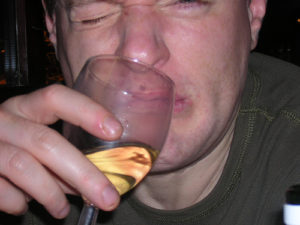
We are continuing on from a post a few days ago on wine faults and flaws, bad wines, their diagnostic, causes and treatment. Hope this info will help make the wine world a slightly better place! 😉
More Wine Faults to Consider
2. Acetaldehyde
Description: Distinctive, straw-like, somewhat acrid character; sherry-like.
Cause: Since acetaldehyde becomes reduced (by alcohol dehydrogenase) to ethanol in the last step of the glycolytic pathway in fermentation it is not surprising to find that in the presence of excess oxygen, ethanol becomes oxidized back to acetaldehyde. Ullage in storage containers, empty fermentation locks, brutal racking, etc. can cause some ethanol to be oxidized to acetaldehyde.
Prevention: Minimize exposure of finished wines to air. Because of their higher phenolic content reds are less susceptible to acetaldehyde production than are whites. Maintain 25 ppm free SO2. Keep fermentation locks topped up and level of wine in storage containers topped up.
Treatment: Add 50 to 100 ppm SO2 if acetaldehyde detected. If oxidation has proceeded too far for that to be effective, treat with potassium caseinate (skim milk powder) or referment.
Judging: At barely detectable levels acetaldehyde may increase complexity but does not make a wine more enjoyable and should be considered a flaw. When readily detectable it is a fault and for most people such a wine is undrinkable. Use of the term ‘oxidation’ to denote the presence of acetaldehyde should be avoided because other wine components may also be come oxidized (e.g., phenolic browning by polyphenoloxidase).
3. MLF in Bottled Wines
Description: Musty, stale dishcloth, swampy characters that may or may not be accompanied by slight spritz. Not responsive to copper. Less objectionable in wines that have undergone MLF than in aromatic white table wines or white social wines where no MLF character might be expected.
Cause: Malolactic bacteria acting on malic acid in bottled wine. The wine was bottled with comparatively low levels and no lysozyme. Usually, the assumption has been made that MLF was completed or that since it was not deliberately added it would not occur.
Prevention: Malolactic conversion should be allowed to run its course and then be tested chromatographically to ensure no malic acid remains, or should be arrested with SO2 and then lysozyme to prevent ML bacteria starting up again in bottle. Wines that have not undergone MLF should not be blended with those that have unless lysozyme protection is used.
Treatment: No practical solution…sorry 🙁
Judging: Depending on intensity such characters are flaws or faults and you should score the wine accordingly. There is no diagnostic test for this problem.
Note: bacterial contamination of lees can produce putrid odours and tastes reminiscent of decomposition. Prevention involves vigilant monitoring and stirring of wines “sur lie”. There is no excuse for entering seriously contaminated wines in competition but if entered they are undrinkable and too unpleasant to taste.
4. Yeast Fermentation in Bottled Wine
Description: Yeasty, effervescent wine that may have stale, dirty characters. Not responsive to copper.
Cause: Wine bottled with residual sugar, viable yeast cells and inadequate SO2 or sorbate. Sugar level was assumed to be too low to ferment further or was not detected.
Treatment: Disgorge and referment entire bottling.
Judging: Wines that are clearly “working” should be scored below 10 points. Slight spritz in the absence of off-characters is acceptable in a dry white table wine or social wine.
5. Ethyl acetate.
Description: The commonest ester in wines, ethyl acetate forms from the reaction of ethanol and acetic acid. It imparts the unmistakable and usually objectionable aroma of nail-polish remover (acetone).
Cause: Ethyl acetate frequently develops in grapes on the vine from contamination with Acetobacter spp. and other aerobic bacteria converting alcohol produced by yeasts in wounds to acetic acid. It is a frequent contaminant of thin-skinned varieties of shipping grapes and of skins of grapes pressed for juice and allowed exposure to air before being used for second runs. Acetic bacteria are ubiquitous but their activity is greatly reduced by low pH, low temperature and anaerobic conditions. Sulphite is lethal to them.
Prevention: Fruit or Grapes – particularly thin-skinned varieties – should be processed as soon as possible after harvest, if the fruit can’t be processed right away into wine, it should be then frozen right away for future thawing and processing.
Treatment: Sometimes ethyl acetate will revert to the much less evident acetic acid but usually, once detected, it is very difficult to correct. Refermentation in another must will reduce it to some extent and bubbling CO2 through a sintered air-stone, then heavy PVPP fining can be effective as a last ditch measure.
Judging: A noticeable acetone character should be considered a serious fault and the wine judged as undrinkable. At almost imperceptible levels ethyl acetate may be considered a contributor to complexity, particularly in reds. Some judges are very sensitive to it and feel justified in rejecting any wine in which the slightest traces occur. (See Volatile Acidity in a future entry)
Come back in a few days for more on this important winemaking topic and let me know what you think, some of your own winemaking experience with wine problems. Sharing our information will help make a world with better wine! I think we can all drink to that.

Hi!
I’m from Puerto Rico and recently started a proyect based on the preparation of artisan wine made with native fruits. I’m in the process of learning about fruit wines and I would like to know how can I pair those wines with different food and/or desserts. If you can give some advices or some tips to get acquainted with the topics. Thanks a lot for your help!!?